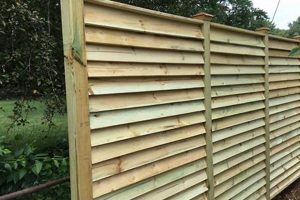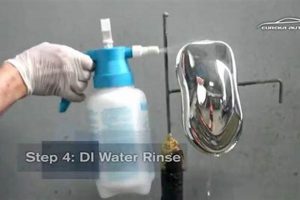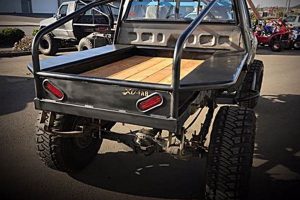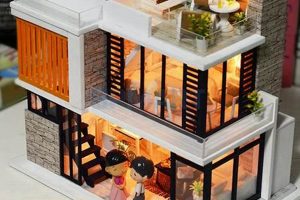A prefabricated shelter structure, designed for vehicle protection from the elements, delivered in component form for homeowner assembly represents a cost-effective solution. These packages typically include all necessary hardware, structural supports, and roofing materials, accompanied by detailed instructions. For example, a homeowner might purchase such a package online and erect it over a weekend using common household tools.
The significance of these structures lies in their affordability and adaptability. They offer a readily available alternative to custom-built carports, providing protection from sun, rain, and snow, thereby extending a vehicle’s lifespan and maintaining its aesthetic appeal. Historically, the increasing availability of these kits reflects a broader trend towards accessible and convenient home improvement solutions.
This article will delve into the diverse types available, factors influencing purchasing decisions, the assembly process, necessary tools and safety considerations, and finally, maintenance and longevity strategies for these structures.
Essential Considerations Before Purchasing a Prefabricated Vehicle Shelter
Prior to acquiring a vehicular shelter delivered in kit form, careful planning and assessment are paramount to ensure suitability and longevity. The following points offer guidance during the selection process.
Tip 1: Assess Local Building Codes and Regulations: Contact the local municipal authority to ascertain permit requirements for structures of this type. Compliance with zoning laws and building codes is mandatory to avoid legal penalties and ensure structural integrity.
Tip 2: Determine Optimal Dimensions: Accurately measure the vehicle(s) to be sheltered, accounting for door clearance and ease of movement. Sufficient overhead clearance is also crucial, particularly for trucks or SUVs.
Tip 3: Evaluate Site Conditions: Analyze the soil composition at the intended installation location. Soil instability may necessitate concrete footings or other reinforcement to guarantee a secure foundation.
Tip 4: Select Appropriate Materials: Consider the climate and environmental conditions prevalent in the region. Opt for materials resistant to corrosion, UV degradation, and extreme weather, such as galvanized steel or powder-coated aluminum.
Tip 5: Review Warranty Information: Scrutinize the warranty offered by the manufacturer. A comprehensive warranty provides assurance against defects in materials and workmanship.
Tip 6: Analyze Assembly Instructions: Request and thoroughly review the assembly manual prior to purchase. Ensure the instructions are clear, concise, and easily understood. Evaluate the complexity of the assembly process to determine if professional assistance is required.
Tip 7: Consider Future Needs: Evaluate potential changes in vehicular ownership or storage requirements. Selecting a slightly larger structure can accommodate future needs and enhance long-term value.
By adhering to these guidelines, individuals can make informed decisions regarding the acquisition of prefabricated vehicular shelters, ensuring structural integrity, regulatory compliance, and long-term satisfaction.
The subsequent sections of this article will explore the intricacies of assembly, maintenance, and strategies for maximizing the lifespan of these structures.
1. Affordability
The primary driver for choosing a vehicular shelter in a ready-to-assemble format frequently centers on cost-effectiveness. Purchasing such a kit presents a tangible opportunity to significantly reduce expenses compared to engaging a contractor for custom construction. This reduction stems from several factors, including minimized labor costs, streamlined manufacturing processes, and the elimination of intermediary markups typically associated with bespoke projects. For instance, a homeowner seeking to protect a vehicle from the elements might find the cost of a prefabricated kit to be half or even a third of that quoted for a comparable custom-built structure.
However, the pursuit of affordability should not eclipse considerations of quality and long-term value. While the initial purchase price may be lower, compromises on material durability or structural design can lead to increased maintenance expenses or premature replacement. Therefore, a comprehensive evaluation of the kit’s components, warranty, and manufacturer reputation is crucial. Selecting a kit with a slightly higher upfront cost but superior materials often proves more economical over the lifespan of the structure.
In conclusion, affordability constitutes a cornerstone of the appeal of these vehicular shelters. While the potential for cost savings is substantial, a balanced approach that considers material quality, structural integrity, and long-term maintenance is essential to realize the full economic benefit. The challenge lies in discerning between genuine value and deceptive cost-cutting measures.
2. Ease of Assembly
The inherent appeal of a vehicular shelter in kit form rests significantly on the premise of simplified assembly. This factor directly influences the overall project cost, time investment, and suitability for individuals without extensive construction experience. The relative ease with which a structure can be erected determines its practicality as a do-it-yourself endeavor.
- Clarity of Instructions
The quality and comprehensiveness of the assembly manual are paramount. Instructions must be unambiguous, logically sequenced, and accompanied by clear diagrams or illustrations. The absence of precise instructions can lead to errors, delays, and structural deficiencies. Kits with video tutorials or interactive online guides further enhance the assembly process.
- Component Design and Pre-fabrication
The design of individual components plays a crucial role. Prefabrication, such as pre-drilled holes and pre-cut materials, significantly reduces on-site modification and simplifies the assembly process. Components designed for intuitive interlocking or snap-fit connections minimize the need for specialized tools or advanced skills.
- Hardware and Fasteners
The inclusion of all necessary hardware, such as bolts, screws, and brackets, is essential. Hardware should be of appropriate quality and quantity to ensure structural integrity. Clearly labeled and organized hardware packs facilitate identification and prevent errors during assembly. The compatibility and ease of use of fasteners directly impact the speed and efficiency of the process.
- Tool Requirements
The type and quantity of tools required for assembly determine the accessibility of the project. Kits designed for ease of assembly minimize the need for specialized tools, relying instead on common household implements
such as wrenches, screwdrivers, and measuring tapes. Reduced tool requirements broaden the appeal to individuals with limited tool collections or construction experience.
In summation, the perceived ease of assembly directly dictates the viability of a vehicular shelter kit as a DIY project. Kits that prioritize clear instructions, intuitive component design, comprehensive hardware inclusion, and minimal tool requirements provide the greatest opportunity for successful homeowner installation. Failure to adequately address these factors can result in frustration, increased costs, and compromised structural integrity.
3. Structural Integrity
Structural integrity, in the context of vehicular shelters delivered as component packages, denotes the capacity of the assembled structure to withstand anticipated environmental loads and stresses without failure. It is a critical attribute directly impacting safety, longevity, and overall value.
- Material Selection and Load Capacity
The choice of materials, such as steel, aluminum, or wood, directly dictates the structure’s ability to bear weight and resist deformation under load. For example, a steel-framed kit designed for a region with heavy snowfall must utilize steel of sufficient gauge and strength to prevent collapse. Exceeding the designed load capacity, by improper snow removal or overloading with storage, compromises structural integrity.
- Connection Strength and Fastener Reliability
The connections between structural elements, achieved through bolts, screws, or welds, represent critical points of potential failure. Insufficient tightening of bolts, use of inappropriate fasteners, or corrosion of metal components can weaken these connections, leading to instability. Regular inspection and maintenance of fasteners are essential to preserve structural integrity.
- Foundation Stability and Anchoring
The foundation upon which the structure rests must provide a stable and level base. Inadequate soil compaction, improper drainage, or insufficient anchoring can lead to settling or shifting of the structure, compromising its integrity. Concrete footings, properly sized and reinforced, are often necessary to provide a secure foundation, especially in areas prone to frost heave or high winds.
- Design Considerations and Wind Resistance
The overall design of the structure influences its ability to withstand wind loads. Aerodynamic designs, bracing elements, and appropriate roof pitch can reduce wind resistance and prevent uplift or collapse. Building codes often specify minimum wind load requirements that must be met to ensure structural integrity in specific geographic areas.
These facets of structural integrity are not mutually exclusive but rather interconnected. A vehicular shelter kit constructed of high-strength steel but improperly anchored to an unstable foundation will still be vulnerable to failure. Similarly, a well-designed structure subjected to loads exceeding its capacity will ultimately experience structural compromise. Therefore, a holistic approach, encompassing appropriate material selection, robust connections, stable foundation, and sound design principles, is essential to ensuring the long-term structural integrity of a vehicular shelter in kit form.
4. Weather Resistance
The ability of a vehicular shelter delivered in a component package to withstand various weather conditions constitutes a critical performance characteristic. Weather resistance dictates the structure’s longevity, protects the sheltered vehicle, and minimizes maintenance requirements.
- Material Degradation and UV Exposure
Prolonged exposure to ultraviolet (UV) radiation can degrade many construction materials, leading to discoloration, embrittlement, and reduced structural strength. Protective coatings, UV-resistant polymers, and the use of materials inherently resistant to UV degradation, such as certain metals, are essential for mitigating this effect. Example: A plastic roof panel lacking UV protection may become brittle and crack within a few years, necessitating replacement.
- Corrosion Prevention and Moisture Resistance
Exposure to moisture, particularly in coastal or humid environments, can lead to corrosion of metallic components. Galvanization, powder coating, and the use of corrosion-resistant metals like aluminum are effective strategies for preventing rust and maintaining structural integrity. Example: Steel support posts lacking a protective coating will corrode over time, weakening the structure and potentially leading to collapse.
- Wind Load Resistance and Structural Design
The structural design must account for anticipated wind loads in the region. Aerodynamic profiles, reinforced connections, and appropriate anchoring methods are crucial for preventing uplift or collapse during high winds. Building codes often specify minimum wind load requirements that must be met. Example: A carport with a poorly designed roof may act as an airfoil in high winds, creating lift forces that can detach the structure from its foundation.
- Water Drainage and Snow Load Capacity
Effective water drainage is essential to prevent water pooling on the roof, which can lead to leaks, structural damage, and increased weight loads. Similarly, the structure must be designed to withstand anticipated snow loads in regions with heavy snowfall. Roof pitch, support spacing, and material strength are key factors. Example: A flat or low-pitched roof may accumulate excessive snow, exceeding the structure’s load capacity and causing collapse.
Collectively, these elements underscore the importance of selecting a vehicular shelter package designed for the specific climatic conditions of its intended location. Prioritizing weather resistance ensures long-term performance, protects the sheltered vehicle, and minimizes the need for costly repairs or replacements. These factors demonstrate the clear link between weather resistance and overall satisfaction with the purchase.
5. Code Compliance
Adherence to local building codes represents a non-negotiable aspect of any vehicular shelter project, particularly those involving prefabricated kits intended for homeowner assembly. Failure to comply with relevant regulations can result in fines, mandatory removal of the structure, and potential legal liabilities.
- Permit Acquisition Requirements
Most jurisdictions mandate the acquisition of building permits prior to the erection of any permanent or semi-permanent structure, including vehicular shelters. The permit application process typically involves submitting detailed plans of the proposed structure, including dimensions, materials, and anchoring methods, to the local building department for review. Non-compliance may lead to stop-work orders and significant financial penalties. Example: Erecting a carport without a permit in a municipality requiring one can result in fines exceeding the cost of the permit itself.
- Zoning Regulations and Setback Requirem
entsZoning ordinances dictate permissible land usage and often specify setback requirements, which define the minimum distance a structure must be from property lines. Vehicular shelters must conform to these regulations to avoid encroachment on neighboring properties or violation of zoning laws. Non-compliance may necessitate relocation of the structure or legal action. Example: A carport erected too close to a property line may violate setback requirements, prompting legal disputes with neighbors and potential court orders for removal.
- Structural Safety Standards and Wind Load Requirements
Building codes incorporate specific structural safety standards designed to ensure the stability and integrity of structures under various environmental conditions, including wind, snow, and seismic activity. Vehicular shelters must meet these standards to protect occupants, vehicles, and neighboring properties from potential hazards. Compliance often requires engineering certifications or adherence to prescribed construction methods. Example: Carports in hurricane-prone areas must be designed and constructed to withstand specific wind loads as defined by local building codes.
- Electrical Code Compliance (if applicable)
If the vehicular shelter incorporates electrical components, such as lighting or outlets, strict adherence to electrical codes is mandatory to prevent fire hazards and ensure electrical safety. This includes proper wiring, grounding, and the use of approved electrical fixtures. Non-compliance can result in electrical shock hazards and potential property damage. Example: Improper wiring in a carport’s electrical system may create a fire hazard or pose a risk of electrocution.
Navigating the complexities of building codes requires diligence and attention to detail. Prospective purchasers of vehicular shelter kits are strongly advised to consult with local building officials to ascertain all applicable regulations and ensure full compliance. This proactive approach minimizes the risk of costly errors and legal repercussions, securing a safe and compliant structure.
6. Space Optimization
Space optimization, in relation to vehicular shelters delivered in kit form, concerns the efficient utilization of available area to maximize protection and usability without undue spatial encroachment. Selection of an appropriately sized kit directly influences property value, aesthetics, and accessibility. Overly large structures can dominate a landscape, potentially violating neighborhood covenants or impeding pedestrian and vehicular traffic. Conversely, undersized shelters may fail to adequately protect vehicles, negating their primary purpose.
The dimensions of the vehicle(s) to be sheltered, combined with anticipated future needs, dictate the necessary interior space. Furthermore, consideration must be given to door clearances, ease of movement around the vehicle, and potential storage requirements for related equipment. Examples include selecting a carport wide enough to accommodate both a standard sedan and a motorcycle or choosing a structure with sufficient height to allow for the loading and unloading of cargo carriers. Careful measurement and planning are essential to achieving optimal space utilization. The kit components should ideally facilitate a streamlined profile without compromising structural integrity, allowing for integration with existing landscaping and architectural features.
Ultimately, effective space optimization with vehicular shelter kits involves balancing functional requirements with aesthetic considerations and regulatory constraints. Prioritizing careful measurement, thoughtful planning, and a clear understanding of local zoning ordinances ensures the selected structure provides adequate protection and enhances the overall property value. Addressing these factors fosters a seamless integration into the property, minimizing negative impact while maximizing practical benefits.
Frequently Asked Questions Regarding Prefabricated Vehicular Shelters
This section addresses common inquiries concerning vehicular shelters supplied in component form, offering concise explanations and practical guidance.
Question 1: What are the primary advantages of a “diy carport kit” compared to custom-built alternatives?
Prefabricated solutions typically offer lower upfront costs, simplified assembly processes, and readily available standardized designs. Custom-built structures, while offering greater design flexibility, generally entail higher material and labor expenses.
Question 2: How is the long-term durability of a “diy carport kit” ensured?
Durability hinges on material selection, construction quality, and proper maintenance. Opting for kits constructed from corrosion-resistant materials, such as galvanized steel or aluminum, and adhering to recommended maintenance schedules are critical for longevity.
Question 3: What level of expertise is required for successful assembly of a “diy carport kit”?
The required expertise varies depending on the complexity of the kit. Simpler designs may require only basic tools and minimal construction experience, while more intricate structures may necessitate advanced skills or professional assistance.
Question 4: Are building permits universally required for the installation of a “diy carport kit”?
Building permit requirements vary significantly depending on local regulations. Contacting the municipal building department is essential to ascertain specific permit requirements for the intended installation location.
Question 5: How are wind and snow loads addressed in the design of a “diy carport kit”?
Reputable manufacturers design their kits to meet or exceed local building code requirements for wind and snow loads. Reviewing the kit specifications and consulting with local building officials is crucial to ensure adequate structural capacity.
Question 6: What recourse is available if a “diy carport kit” exhibits manufacturing defects or structural deficiencies?
Most manufacturers offer warranties covering defects in materials and workmanship. Reviewing the warranty terms and conditions prior to purchase is advisable to understand the available recourse in the event of product failure.
Understanding these factors enhances the likelihood of a successful acquisition. Due diligence is vital for informed decisions and risk mitigation.
The following sections will focus on optimal maintenance strategies to prolong the lifespan of these structures.
DIY Carport Kit
This article has explored the multifaceted aspects of the “diy carport kit,” from initial considerations and purchasing decisions to assembly, maintenance, and code compliance. The analysis underscored the significance of affordability, ease of assembly, structural integrity, weather resistance, code compliance, and space optimization as essential criteria for informed decision-making. The content emphasized that selecting an appropriate kit requires a balanced assessment of needs and resources, adhering to local regulations, and implementing preventive maintenance strategies.
The acquisition of a vehicular shelter in kit form represents a substantial investment that warrants meticulous planning. The long-term value derived from such a purchase hinges on a commitment to proper installation and ongoing maintenance. Continued awareness of evolving building codes and adaptation to changing environmental
conditions remain paramount for realizing the full potential of the chosen structure.






![DIY Drum Kit Mastery: Build Your Sound [Guide] The DIY Hub: Creative Crafts, Repairs & Life Hacks DIY Drum Kit Mastery: Build Your Sound [Guide] | The DIY Hub: Creative Crafts, Repairs & Life Hacks](https://craftingdiycenter.com/wp-content/uploads/2025/07/th-4882-300x200.jpg)
